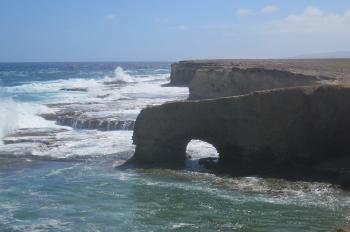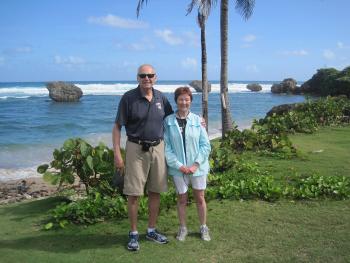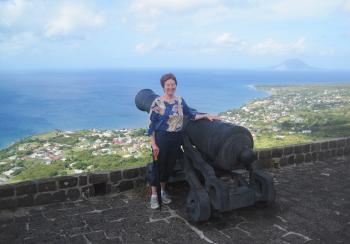Exploring the Caribbean islands spared by the storms of ’17
This article appears on page 34 of the July 2018 issue.
Tourism to the Caribbean in the fall of 2017 took a big hit following the significant damage done by hurricanes Irma and Maria. Cruise ships responded to the situation there by canceling or modifying their itineraries, and passenger bookings dropped.
By early November, the prospect of empty cabins precipitated some great last-minute bargains for frugal travelers like me.
As the southern islands in the Caribbean chain had escaped most of the hurricanes’ impact, a 7-day cruise on the Celebrity Summit (beginning Jan. 6, 2018) to Barbados, Antigua, St. Kitts, Saint Lucia and St. Thomas sounded like a perfect fit for my husband, Lynn, and me. With Celebrity’s sale price, we secured a window-view cabin for a total of $1,160 for the two of us, including taxes and port charges. Except for St. Thomas, all of these were islands we had never seen.
A tumultuous start
One last hurdle remained: the cruise departed from San Juan, Puerto Rico, still reeling from the aftereffects of the hurricanes. However, their airport was already back in service, so I booked round-trip tickets for us on Southwest Airlines between Orlando, where some of our relatives lived, and San Juan.
Ensconced with family in Orlando, we nervously watched weather reports as a “bomb cyclone” devastated the eastern coast of the US in early January. By the fifth of the month, over 6,000 flights were either canceled or delayed. Amazingly, our January 6th flight to San Juan was still on track for departure.
Lynn and I arrived at the Orlando airport to find our flight completely filled. Moreover, an additional 33 standby passengers waited hopefully for any empty seat. Thank goodness for our confirmed reservations!
In San Juan, the devastation from the storms was painfully visible. Some hotel windows were boarded up, parts of the damaged airport were cordoned off, and our cab driver confided that he was still without power.
On board the ship, the captain announced that our departure would be delayed until 9:30 p.m. to accommodate late arrivals. Even so, the ship eventually sailed without more than 200 guests (almost 10 percent of all booked passengers).
Island tour
After a day at sea, we arrived at our first port of call: Bridgetown, Barbados. Previously, through our cruise’s online Roll Call (a forum for cruise passengers on a particular sailing) at cruisecritic.com, I had arranged to team up with another couple who had been looking for two additional members to split their $150 cost for a private, 4-hour tour of the island that they had booked through Glory Tours (glory tours.org). Our enticement? This couple intended to focus on natural beauty and hiking and emphasized they were not interested in “shopping opportunities” or rum-factory visits.
By great good fortune, our guide/driver was Charles Marshall, a personable middle-aged man who had been giving tours for years and was completely on board with our agenda.
We began with a half-hour drive to the east coast, where our van pulled into the parking lot of a clean public beach with restrooms available. This was Bathsheba, a stunning stretch of white sand rimming a hillycoastline that sloped to the sea.
The beach’s most dramatic feature, however, was the presence of enormous chunks of coral that had broken away from ancient reefs and now lay scattered like giant tiddlywinks along the shoreline. Frothing cascades of water from the Atlantic swirled amidst these huge boulders.
No other visitors were around as the four of us followed a narrow trail cut into the hillside above the ocean and rimmed with wildflowers. Gorgeous!
The next stop was at my request. I asked our guide to take us where no tour bus could go, a place that was special to him. Charles’ face lit up as, without hesitation, he exclaimed, “If I had lots of money, I will take you where I would build my house.”
Fifteen minutes later, he pulled off onto an unpaved side road and stopped in front of a big cow pasture. Everyone piled out.
“Watch your step!” he cautioned as we gingerly avoided cow patties and a big, black bull that was chained to an iron post in the ground.
Arriving at the cliff’s edge, it was immediately apparent why this was such an exceptional place; the view below encompassed a scenic peninsula embracing a bay of rolling whitecaps. A cool breeze ruffled our hair. Just spectacular!
More spectacular sights
I didn’t think anything on this island tour could top what we had already seen, but our next destination was probably my favorite of the entire cruise: Little Bay, set amongst the rugged cliffs of Barbados’ northeastern coast.
Fingers of shoreline jutted into the ocean, having been carved by the elements into fantastic shapes and arches, great plumes of ocean spray erupting from numerous blowholes.
With the arrival of each wave, instant waterfalls were created on the partially submerged shelves of land beyond these formations. (Supposedly, at low tide, natural pools appear and swimming is possible, but how could that compensate for the dramatic display the high waters provided?)
Last on the tour was Animal Flower Cave, on the northern coast, named for the sea anemones found in pools of water in the cave.
Our guide had already informed us that most of the anemones were lost during the hurricanes, so we weren’t too disappointed to find a sign at the entrance stating that the cave was closed due to high waters. The good news? The closure meant fewer visitors, and we were able to enjoy the clifftop, outdoor bar/restaurant and viewing areas without crowds.
Upon our return to the port, we saw that some new cruisers with luggage in tow had caught up with the ship. In fact, Lynn and I heard a number of air-travel horror stories over the next several days from passengers forced to fly into Barbados or Saint Lucia to catch the ship. (These were the lucky ones; almost a hundred folks never did make it.)
Saint Lucia
The following day, our ship docked at Castries, Saint Lucia. Saint Lucia is known for its iconic Pitons — two volcanic spires designated as a World Heritage Site — and they were definitely on my must-see list. Internet chatter had warned of long, twisting roads from the port to the Pitons, with some posters claiming the drive in the heat produced such nausea that sick bags were imperative. OK then. If not by land, then by sea.
I prebooked the “Jalousie/Sugar Beach Break” online with Spencer Ambrose Tours (St. Lucia; spencer ambrose.com). The 6- to 7-hour tour cost $90 apiece, including round-trip transportation to Sugar Beach (nestled close to the Pitons) via speedboat from Castries as well as lunch, drinks and snorkeling equipment.
Our speedboat made several detours before reaching its destination — one of them to view a bat cave and the other to visit Marigot Bay, with its ritzy yachts.
I had not realized that all beaches in Saint Lucia are, by law, open to the public, thus at Sugar Beach we were not just confined to “our” little section, with its pebble-strewn water access, but were permitted to swim and stroll along the pristine shoreline at the adjoining (and very luxurious) Sugar Beach Viceroy Resort.
A sort of symbiotic relationship existed for all guests. The resort boasted the best sand, while the more rocky section had the most fish.
We really enjoyed our time there. A number of colorful fish could be observed while snorkeling, and the Creole buffet lunch provided at the beach was delicious. Beer and a great rum punch were always available, as well as nonalcoholic beverages.
In our opinion, the view of the Pitons, alone, was worth taking this tour.
A day for relaxing
The next morning, we arrived at St. John’s, Antigua. Lynn and I were off the ship early, intending to catch a taxi to Valley Church Beach. At the dock, enterprising drivers hustled to maximize profits by rounding upeight passengers (at $8 apiece) for each van. Fortunately, this didn’t take long with so many passengers exiting from the ship at once.
Valley Church was one of the more distant beaches, which we chose precisely because Internet feedback complained of its “lack of action” (i.e., no jet ski watercraft or nearby casinos). What the place did have was a long, lovely stretch of beach with facilities and changing rooms as well as a small bar and restaurant.
There was no admission charge, just a $10 fee to rent an umbrella or chair. We planted our umbrella as far away from the majority of visitors as possible, on a nearly deserted section of beach. Wave action resulted in somewhat cloudy water with an abrupt drop-off, but beyond the surf, the ocean was perfect for swimming.
Later, back in St. John’s, we had time for shopping and were pleasantly surprised at the quality of goods available in the quaint duty-free area at Heritage Quay. It was a nice, relaxing day.
St. Kitts
We continued on to the island of St. Kitts, where we docked in the town of Basseterre. For $150, I had engaged the services of a local guide/driver, Leo Christopher (christopherom95@gmail.com), because of his excellent reviews on tripadvisor.com.
St. Kitts was probably Lynn’s favorite island, as he is a history buff. Leo took us first to Romney Manor, built in the 17th century by the Earl of Romney, who purchased the land from the original owner, Sam Jefferson II (supposedly an ancestor of Thomas Jefferson). Currently, Romney Manor houses Caribelle Batik, where artisans have manufactured and sold batik items for the last 30 years.
Of more interest to us was the adjoining ruins of an old sugar-processing factory and its extensive grounds, with over 6 acres of beautiful botanic gardens. The centerpiece was an absolutely huge saman tree.
Leo noticed our interest and confided that his grandmother had been an avid herbalist who had passed down her knowledge to him. Because of this tidbit of information, our tour shifted focus.
At our request, Leo made a number of stops to show us various wild plants and herbs still used medicinally. We also were introduced to (and tasted) the products of indigenous fruit and nut trees on the island.
The highlight for us was an enormous Santo Domingo mahogany tree. Ancient trees of this particular type of mahogany are almost nonexistent today, since they were harvested extensively in colonial times for shipbuilding and to make high-end furniture.
Brimstone Hill Fortress, a UNESCO World Heritage Site, was another attraction we enjoyed. Prominent on this site is the Citadel, one of the best-preserved examples of British polygonal fortification in the world.
With few other visitors around, we were free to explore the grounds and enjoy the phenomenal views from the lofty hilltop perch of the fortress.
Finally, we drove up the northeastern coast to an expansive overlook of the Black Rocks. This product of volcanic action had been carved by water erosion into unique shapes.
Some vendors were on site, one of them cooking the most delicious fried coconut balls — a perfect light lunch!
Heading home
Our last cruise port, St. Thomas, was where the Virgin Islands had borne the brunt of the hurricanes. As the ship neared land, I counted five vessels still wrecked on the shoreline, and we berthed at an unfamiliar dock within an industrial area.
Although I originally intended to ferry to nearby Water Island, this hope was squelched after learning the ferry was now a 45-minute taxi ride away. Besides, the wind was really picking up.
Shuttles were provided to Charlotte Amalie’s tourist area, but, having been there several times before, we declined that option and went ashore only briefly to purchase some sodas.
The next morning our ship arrived back in San Juan. Despite our Global Entry passes, the computers were not working at the dock and everyone needed to be manually cleared by Immigration and Customs. Fortunately, with only carry-on luggage, we were among the first off the ship, and we easily caught a cab to the airport.
Our flight out of Puerto Rico was delayed for several hours, giving us plenty of time for conversations with local passengers, several of whom were escaping to the mainland after months without electricity.
This had been a great trip, but I don’t think either of us will ever take Mother Nature for granted again.




